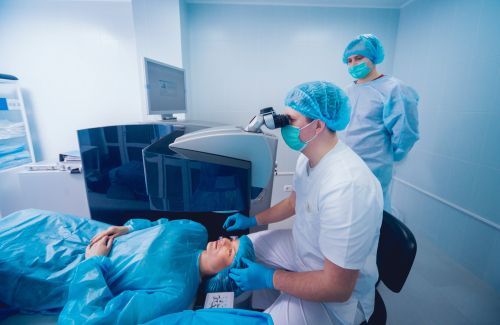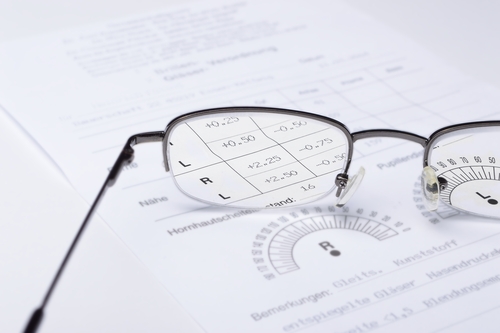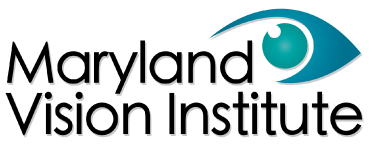Embrace Clearer Vision with LASIK!
September 8, 2023
Imagine seeing clearly, without the need for visual aids, from when you first open your eyes in the morning to the moment you close them for a good night’s sleep! When you correct your eyesight with LASIK at Maryland Vision Institute, around-the-clock clear vision can be your reality.
Keep reading to learn how you can embrace clearer vision with LASIK!
What is LASIK?
LASIK, which stands for Laser-Assisted In Situ Keratomileusis, is vision-correcting refractive eye surgery. LASIK can be used to correct a range of refractive errors, including nearsightedness, farsightedness, and astigmatism, where vision is affected by the irregular shape of the eye. 
LASIK is the most well-known and most commonly performed vision-correcting procedure available today. LASIK also has a very high satisfaction rating, with over ninety-six percent of LASIK patients happy with their results!
LASIK surgery is a quick procedure performed right in the MVI offices. It typically has short recovery times, and most LASIK patients experience restored vision within a few days following surgery.
Although recovery times vary, the eyes fully heal from LASIK in approximately three months.
Who is a Good Candidate for LASIK?
To be a good candidate for successful LASIK surgery, you should meet the following criteria:
You Are At Least Eighteen Years Old
Hormonal changes during puberty affect your eyes and vision, but by the age of eighteen, it is likely that your eye prescription is stable. If you are over the age of forty, LASIK may not be the best vision-correcting treatment for you.
In this case, your eye surgeon may recommend another option.
You Have a Stable Prescription
LASIK is most successful for individuals who have had a stable glasses or contact lens prescription for at least two years. A fluctuating prescription may affect the clarity of your vision after LASIK.
Your Prescription is Within the Acceptable Range
For individuals with severe near- or farsightedness, LASIK may not be the best way to restore clear vision. If you have an eye prescription that exceeds the strength for successful LASIK surgery, you may be a good candidate for other vision-correcting procedures.
You Do Not Have Untreated Dry Eye Syndrome
Untreated dry eye syndrome can cause serious complications, like longer recovery times and severely irritated eyes following LASIK surgery. Having dry eye syndrome does not immediately affect your candidacy for LASIK as long as it is being successfully treated.

Your Corneas are Thick Enough
In order to create the flap during LASIK, which allows your eye surgeon to reshape your cornea and restore your vision, you must have corneas that are thick enough for successful LASIK surgery. Performing LASIK on individuals with thin corneas can compromise their vision.
You Are in Good Overall Health
If you have certain systemic health conditions, like diabetes, rheumatoid arthritis, or other autoimmune diseases, LASIK may not be recommended for you. These conditions can cause complications post-surgery that can further impair your vision.
What Happens During LASIK?
On the day of your LASIK surgery, your eye surgeon will first numb your eye area with special eye drops. This is to prevent any pain or discomfort during the actual procedure.
Your eye surgeon will then use a laser to create a flap on the surface of your cornea, which is the clear outer layer of your eye. This incision is very tiny.
At Maryland Vision Institute, our surgeons use all-laser, or “blade-free,” technology to create the flaps during LASIK surgery. Using a laser to create flaps during surgery has been shown to be much safer and more precise than using a traditional surgical blade.
Once a flap is created, your eye surgeon uses the laser to reshape your cornea, correcting the refractive error that causes your vision to be blurry without visual aids. Maryland Vision Institute increases the accuracy of corneal sculpting with PerfectPulse Technology which guides the laser using a high-speed eye tracker which follows the eye’s movement, increasing speed, precision, and safety.
Once the cornea has been reshaped, your LASIK surgeon will replace the flap, which usually fully heals on its own without the need for any stitches.
What Happens After LASIK Surgery?
With our LASIK expertise and advanced technologies, our average LASIK treatment times are under a minute per eye! From start to finish, LASIK surgery takes about thirty minutes.
 Following surgery, you will need to have someone drive you home, where you should spend some time resting and allowing your eyes to begin the recovery process. Most LASIK patients find that they are able to resume their normal activities as soon as the day after surgery.
Following surgery, you will need to have someone drive you home, where you should spend some time resting and allowing your eyes to begin the recovery process. Most LASIK patients find that they are able to resume their normal activities as soon as the day after surgery.
Though rare, if you do experience any complications following surgery, you should contact your eye surgeon right away to avoid damaging your eyes or compromising your vision. When you are finally ready to break free from reliance on corrective eyewear, LASIK eye surgery can help you gain independence!
With LASIK, you can embrace life with clearer vision and greater visual freedom!
Are you interested in learning more about LASIK or determining if you may be a good candidate for the procedure? Schedule a LASIK consultation at Maryland Vision Institute in Hagerstown, MD, today!



